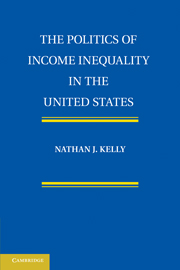Book contents
- Frontmatter
- Contents
- List of Figures
- List of Tables
- Acknowledgments
- 1 Explaining Income Inequality
- 2 The Distributional Force of Government
- 3 Political Conflict over “Who Gets What?”
- 4 Party Dynamics and Income Inequality
- 5 Macro Policy and Distributional Processes
- 6 Putting the Pieces Together: Who Gets What and How
- 7 Distribution, Redistribution, and the Future of American Politics
- Appendix A Congressional Questionnaire
- Appendix B Measuring Income Inequality over Time
- Bibliography
- Index
6 - Putting the Pieces Together: Who Gets What and How
Published online by Cambridge University Press: 24 October 2009
- Frontmatter
- Contents
- List of Figures
- List of Tables
- Acknowledgments
- 1 Explaining Income Inequality
- 2 The Distributional Force of Government
- 3 Political Conflict over “Who Gets What?”
- 4 Party Dynamics and Income Inequality
- 5 Macro Policy and Distributional Processes
- 6 Putting the Pieces Together: Who Gets What and How
- 7 Distribution, Redistribution, and the Future of American Politics
- Appendix A Congressional Questionnaire
- Appendix B Measuring Income Inequality over Time
- Bibliography
- Index
Summary
The previous two chapters tested the central predictions of power resources theory and the macro politics model for distributional outcomes in the United States. Chapter 4 demonstrated that Democratic control of the presidency is associated with lower levels of income inequality, and this is the case because explicit redistribution is greater and market inequality is lower when a Democrat is in the White House as opposed to a Republican. This is consistent with the main predictions of power resources theory and my extension of it to the U.S. case. Chapter 5 focused on public policy as a central variable in the macro politics model and assessed whether leftward shifts in macro policy produce reductions in inequality. The evidence supported the conclusion that the macro politics model can be extended to distributional outcomes. Like Democratic Party control, public policy liberalism reduces inequality via both market conditioning and explicit redistribution.
The models examined in the previous two chapters are depicted in the form of a path model in Figure 6.1. The light solid lines are the paths analyzed in both Chapters 4 and 5. The heavy dotted lines represent paths examined in Chapter 4 alone, and the heavy solid lines are the paths examined in Chapter 5 alone. The essential item to note from this diagram is that the analysis to this point has treated all explanatory factors as influencing distributional outcomes in a single causal stage.
- Type
- Chapter
- Information
- The Politics of Income Inequality in the United States , pp. 136 - 161Publisher: Cambridge University PressPrint publication year: 2009



